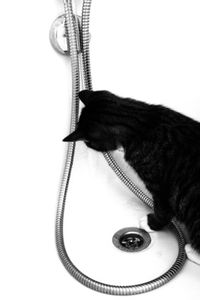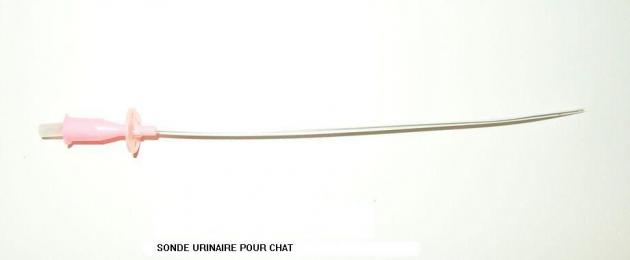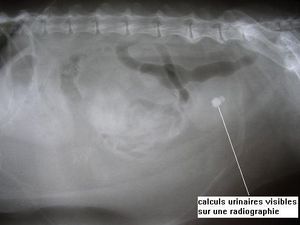Dirtiness associated with urinary tract disease in cats
 A cat that urinates outside of his litter box does not necessarily to "annoy" its masters"or"revenge"of anything.
A cat that urinates outside of his litter box does not necessarily to "annoy" its masters"or"revenge"of anything.
Indeed, certain specific circumstances, as a sharp pain that can feel the cat every time he tries to urinate, can encourage him to do other than in the litter, place the animal will quickly associated with his suffering.
Several types of urinary problems can trigger pain with urination, including cystitis, calculations or tumors of the urinary tract.
Crystals and urinary calculi
¤ Circumstances of occurrence and symptoms
– In cats, a change of pH of the urine can cause the appearance of urinary crystals :
For example, struvite crystals can grow in basic medium while too acidic urine can give birth to cystine crystals.
– These crystals can then agglomerate and form of calculations. These will cause significant inflammation of the bladder (or cystitis) and urinary tract irritation.
Any emission of urine becomes particularly painful : the cat meows, complains, it emits very often very small amounts of urine often reddened with blood.
The animal Associates very quickly his pain with the fact to go the litter and will develop a real aversion for her, then trying to urinate elsewhere (urine found in the lavatory, the bath…)
– Among the male cat, the presence of these crystals and calculations can even lead to a genuine obstruction of urinary tract :
Indeed, the male, the urethra (duct that allows the passage of urine from the bladder to the outside environment) has an extremely small diameter. A urinary calculation or very numerous crystals grouped in a sort of "sand" will be easily able to come "meatman" this narrow passage.
The urine then accumulate in the bladder which becomes huge then go back to the kidneys, triggering a severe renal failure. The cat stops feeding, It seems particularly shot and may present with vomisements and serious cardiac disorders. If no action is taken, therenal failure and its consequences can lead to the death of the cat in only a few days!
– Your veterinarian should quickly be aware of disorder, any Urinary uncleanliness so that it excludes the presence of urinary calculi or instead to put in place an appropriate treatment as quickly as possible if calculations are detected.
¤ Diagnosis
Several examinations are necessary for highlighting crystals or urinary calculi :
– The palpation of the bladder by the veterinarian can sometimes reveal a pain or detect abnormally large bladder (bladder globe) in the case of urinary tract obstruction
– One urinary test strip can highlight the presence of blood in the urine as well as an inadequate pH
– One Review Cytobacteriological urine revealed the presence of crystals
– Most urinary calculi (struvite, calcium oxalate, calcium phosphate) may be highlighted on a radiography.
Others, non-radiopaque will require implementing either an x-ray after injection of a contrast, be one ultrasound examination.
– Ultrasound allows , not only, visualize calculations bladder but also Crystals present in large quantities forming a sort of "sand" in the bladder.
– If the crystals have been detected in the urine of your cat, the veterinarian will suggest a diet adapted to :
Either to dissolve the Crystals present in the case of the struvite,
Is to prevent the formation of additional crystals for other types of crystals.
Distributed food indeed will aim to maintain the urine at a definite pH, opposition to the formation of all types of crystals and calculations.
This tailored diet may, Furthermore, be distributed in wet form (swill or freshness pouches) to dilute more urine and thus promote the elimination of crystals and reduce their training.
– If the calculations large size have been highlighted, surgery is often necessary. It is to open the bladder, remove the calculations and to achieve a meticulous rinse to eliminate small size calculations and crystals that it may contain.
– Case of obstruction :
Urinary obstruction is a true emergency : the cat should be "led" as quickly as possible in order to avoid installation of severe renal failure and all its consequences.

To do this, the veterinarian will introduce a small sensor in the urinary tract of the cat "plugged" in trying to repel the calculation or the "sand" obstructing the penis. This probe is then held in place, sometimes for several days, until the inflammation of the urinary tract decreases and the urethra to become again permeable.
There still, an appropriate diet must be put in place to avoid any risk of recurrence.
A second surgery will be performed when the animal has found a good general condition to retrieve the present calculations in the bladder.
Tumors of the urinary tract
– Some tumors will be able to cause the same symptoms as those experienced in the presence of urinary calculi :
the cat starts to urinate much more frequently, seems to have difficulty to, and can complain when he urinates.
There still, blood can be found in the urine and the cat, that has hurt every time he goes to the litter, can no longer dare to go there and to do so elsewhere.
Urinary incontinence may be added to these symptoms.
– These disorders will appear especially in the presence of a bladder tumour or a tumor of the urethra (conduit allowing the evacuation of urine inside the bladder to the outside).
– These tumors can be highlighted by examinations ofmedical imaging as ultrasound or a test called pyelography study (an opaque product x-ray is injected into the animal and allows to highlight on an x-ray of urinary tract anomalies)
Infectious cystitis – Idiopathic cystitis
The inflammations of the bladder or cystitis are not necessarily secondary to the presence of bladder stones.
They may also be the result of a bacterial infection or idiopathic (that is to say that no good cause specific does understand the origin of the inflammation).
Infectious cystitis
¤ Origin
Some cystitis are related to the presence of a bacterial infection. They are much less frequent than the inflammation associated with the presence of crystals or urinary calculi.
These infections are very often secondary to another disease :
– congenital malformation : anatomical abnormality can facilitate the entry of germs in the bladder.
– extension of infection genital tract
– problem ofurinary incontinence or bladder atonic (the bladder muscles provide then more draining full bladder and urine which is stagnating favour the emergence of infections)
– secondary to a systemic disease such as diabetes (This condition alters the composition of the urine and promotes the proliferation of bacteria in the bladder), or even the hyperthyroidism
– Tumors
¤ Diagnosis
 – One urinary test strip reveals anomalies such as the presence of blood or protein in the urine.
– One urinary test strip reveals anomalies such as the presence of blood or protein in the urine.
– Urine will be collected in order to achieve a cyto-bacteriological examination for identification of bacteria. This examination is useful, not only, for the bacteria responsible for the infection, but also the effective antibiotics to treat.
– Finally, faced with chronic bacterial cystitis, of additional examinations (x-rays, Ultrasound, blood tests) may be proposed for a course cause of these infections (tumor, Diabetes, malformation of the urinary tract…)
¤ Treatment
 – The treatment of infectious cystitis revolves around the administration of antibiotics.
– The treatment of infectious cystitis revolves around the administration of antibiotics.
When the cystitis are frequent, cyto-bacteriological examination of urine allows highlighting of the bacteria in question and therefore an accurate adaptation of the treatment.
– Your veterinarian will prescribe, Furthermore, a drug to reduce spasms and thus reduce the pain experienced by the animal when he urinates.
Idiopathic cystitis
Some cystitis called idiopathic cystitis seem to be explained by any of the causes mentioned previously :
– Radiographic and echographic examinations reveal no abnormalities (absence of tumor, absence of calculation) examination of the urine cannot detect or crystals, or bacteria. Only irritation of the bladder wall can sometimes be highlighted.
– However, the cat presents all signs of cystitis with complaints, pain during urination, blood in the urine and can sometimes even become totally unable to urinate, as in the case of bladder globes associated with urinary stones.
– In these cases of idiopathic cystitis, of signs of anxiety and stress must be wanted in cats.
Indeed, It seems that the frequency of these cystitis decreases in some animals through the implementation of treatments used in anxiety disorders such as an enrichment of the living environment, a reorganization of the space or a change in the mode of distribution of food…
Your veterinarian will then look for other signs of anxiety are present in your pet (bulimia, chronic diarrhea, intensive licking, aggressiveness in certain situations or at certain times of the day…) and will attempt, If this is the case, determine with you the origin of this stress.
(see article :"Urinary uncleanliness linked to the environment of the cat")
Diseases of an increase beverage making
Some pathologies such as diabetes mellitus, renal failure, a uterine infection, hyperthyroidism, or even a liver disorder are associated with a net increase in intake of drink.
In this case, the uncleanliness is not related to an aversion to the litter but to the significant increase in the amount of issued urine : cat litter is then very quickly saturated with urine and the cat done elsewhere.
If you notice an increase in the amount of water consumed by your pet, talk to your veterinarian so he can search for the presence of one of these diseases.
§
The appearance of uncleanliness in cats can be linked to various diseases sometimes very painful.
It is worth quickly evoke these urinary disorders with your veterinarian :
Indeed, If a solution allowing to eliminate the pain of the cat when it urinates is not quickly implemented, the repulsion for litter can persist in time and relearn the cat in a litter will be extremely difficult.

